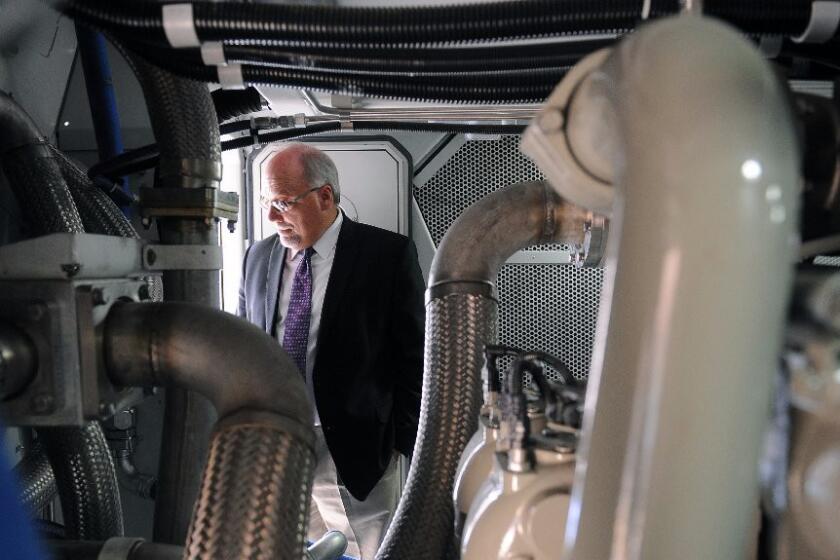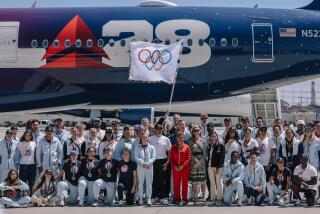Battery-powered trains could be a climate game changer. Is everyone all aboard?
- Share via
Colossal freight locomotives are a fixture of the American landscape, but their 4,400-horsepower engines collectively burn 3.5 billion gallons of diesel annually, at a time when railroads and other fossil fuel users face pressure to reduce pollution and greenhouse gas emissions.
With little fanfare, however, the industry has begun operating locomotives that run on stored electrical power, moving toward a future in which toy shops are not the only source of battery trains. American passenger lines could also be transformed by the technology, though California rail officials say it will not work for the state’s bullet train.
In a just-completed test, BNSF ran a freight train from Barstow to Stockton with an experimental battery locomotive, coupled with two diesel locomotives, and achieved an 11% reduction in fuel consumption, along with similar reductions in emissions of nitrogen oxides, small particulates and greenhouse gases. An upgraded future operational version is expected to improve fuel efficiency by 30%.
The test was a “defining moment for freight rail,” accelerating the industry to eventual zero-emission locomotives, said Eric Gebhardt, chief technology officer at Wabtec, which developed the system at its research center near Lake Erie in northern Pennsylvania.
Battery- and hydrogen fuel cell-powered trains are among the rail industry’s only viable options for reducing greenhouse gases. Every battery locomotive that replaces a diesel will reduce carbon dioxide emissions by 3,000 tons per year, Wabtec estimates.
But it is unlikely they can quickly replace diesel-powered trains. U.S. freight railroads are awash in surplus locomotives and nobody can predict what battery-operated systems will cost, compared with existing $3-million diesels.
“Battery locomotives are feasible,” said Michael Iden, a consultant who was Union Pacific’s longtime director of locomotive engineering. Iden compares Wabtec’s achievement to the Wright brothers’ first powered flight: a proof of concept ready for development. They will be tested soon in California ports and rail yards, he noted.
That said, “Estimating the cost of commercially available in production battery locomotives is, in my opinion, like forecasting the price of multiple fully landscaped four-bedroom, three-car garage homes with in-ground pools on Mars,” Iden said. “Someday such homes may exist on Mars but that’s a long way off.”
Much will depend on the degree that state and federal regulators pressure railroads to clean up their emissions. Here in California, the state Air Resources Board wants railroads to reduce or even eliminate diesels in the next 14 years.
The transportation sector accounts for 29% of U.S. greenhouse gas emissions. Within that category, the rail industry, which moves 40% of long-distance freight, accounts for just 2%, according to U.S. Environmental Protection Agency data. But freight trains as well as trucks expose many populated urban corridors, notably neighborhoods near the ports of Long Beach and Los Angeles, to soot and pollution.
A new state mandate would require 4,000 new zero emission truck sales by 2024 and 300,000 by 2035.
“We can do more,” said Ian Jefferies, president of the Assn. of American Railroads, citing the potential of battery-operated trains. “It is good business to reduce emissions and reduce fuel consumption and is reflective of society’s goals.” At the same time, Jefferies and his organization are pushing back against proposed regulations to eliminate diesels, saying, “It doesn’t make sense.”
Severin Borenstein, an energy expert and professor at UC Berkeley’s Haas School of Business, said railroads are not likely to get a free pass on climate change issues.
“The fact that railroads are already the most efficient transportation source is great, but we all need to reduce greenhouse gases,” he said. “Railroads are a major source of greenhouse gases.”
Apart from freight, battery- and fuel cell-powered trains offer promise to upgrade U.S. passenger rail, which generally runs on rails owned by freight railroads, such as BNSF and Union Pacific. These companies oppose overhead electrical lines — such as those that power urban light rail — because of potential interference with freight operations. Batteries and fuel cell locomotives eliminate that potential conflict.
In San Bernardino, the county transportation authority is waiting for delivery of a hydrogen fuel cell-powered passenger train, which will go into service by 2024 on the Metrolink commuter rail system. The train is under development in Switzerland by Stadler, which also makes a line of high-speed trains that run on wires.
Besides reducing pollution, the Stadler train can accelerate and slow down faster than a diesel, reducing trip times — much like electric vehicles that mimic muscle cars of the 1960s — and is likely to appeal to riders with strong environmental beliefs.
“We are in the beginning of a transition period and there is a lot of movement in the technology,” said Guido Vogel, Stadler’s engineering chief. “There is a political push to get away from diesel propulsion.”
The U.S. rail industry has made key transformations in the past, going from wood to coal and coal to oil, before its current dependence on diesel. Today it operates what is regarded as the most efficient freight system in the world.
About 23,000 locomotives ply the nation’s railway network every day. Half of them operate in California. Even though they are about four times more fuel efficient than big rig trucks — in terms of ton-miles hauled — they burn roughly a gallon of diesel every 2,000 feet.
Add it all up, and this 3.5-billion gallon yearly usage of diesel would fill a river 10 feet deep and 25 feet wide from Los Angeles to Phoenix.
The California Air Resources Board, which helped fund the Wabtec test, believes trains are too big a source of greenhouse gases to escape further regulation.
Air regulators began clamping down on the freight railroads, specifically BNSF and Union Pacific, in 1998, when they signed a voluntary pact that required the use of newer diesel engines that produced less pollution. But the agreement did commit the railroads to use even newer generations of diesel engines. Today, the two railroads operate just 472 of the most modern systems, known as Tier 4 diesels, out of the 11,217 that they run in California at any given time, according to an annual report to the air board.
“There is nothing to compel them to get rid of their Tier 0 locomotives,” said Ajay Mangat, supervisor of the air board’s freight systems section.
The air board staff is preparing complex regulations to eliminate railroad emissions by 2035, though it does depend on technical feasibility, he said. The proposal will go to the air board for a vote next year.
Jefferies, the railroad association chief, said the proposed regulations ignore a 70% voluntary reduction in California emissions since 2005. More pointedly, the association asserts the air board has no legal jurisdiction because railroads are subject only to federal regulation, a long-held entitlement.
Even if the air board doesn’t succeed in imposing tough regulations, railroads, as with other industries, are facing pressure from many directions: shareholders, customers, employees and advocacy groups.
In Japan, Germany, the United Kingdom and the U.S., about half a dozen rail equipment makers are developing systems that would operate trains either on batteries or hydrogen fuel cells, according to an industry research report.
Wabtec’s Gebhardt said the upfront cost of a battery-powered locomotive will be higher than a traditional diesel, but the fuel costs with electrical charging will be lower. Since existing locomotives use diesel engines to generate power that drives electric traction motors, only the generation of the electricity has to be solved.
“It makes economic sense with batteries getting exponentially better,” Gebhardt said.
In the California test, the batteries recharge every time the train slows to a stop, which is frequent along freight routes. The Wabtec train recharged its batteries, through regenerative braking, on the steep 4,000-foot descent from the Tehachapi Pass to the San Joaquin Valley, for example.
The Metrolink commuter railroad on Monday unveiled the first of 40 clean-air locomotives that will replace its aging fleet of diesel engines in an effort to reduce harmful exhaust emissions across the region.
Another battery-powered locomotive will anchor a demonstration project by Pacific Harbor Line in the ports of Los Angeles and Long Beach. The 3,200-horsepower locomotive, made by Progress Rail, a unit of Caterpillar, can haul cars around the port for 24 hours on one charge. Union Pacific just approved the purchase of a battery-operated locomotive for use in one of its California switching yards, as well.
Carrie Schindler, director of transit and rail programs for the San Bernardino County Transportation Authority, said its Stadler two-car train set will be put into service on a newly built nine-mile line between San Bernardino and Redlands, making 16 round trips per day at 79 mph.
An electric train is more energy efficient than an electric car, on a per passenger basis, said Vogel, Stadler’s engineering chief.
Schindler said the $23-million program for the technology development and trainsets will enable significant emission reductions without the huge cost of building overhead high-voltage lines. The Caltrain commuter system between San Jose and San Francisco is paying $2 billion for just 50 miles of overhead wires.
At the moment, it appears unlikely the California bullet train authority will embrace the technology. When asked about it at a recent legislative hearing, Chief Executive Brian Kelly said proposed wireless trains would not satisfy the 220 mph-speed mandate, written into law. The rail authority is in the process of issuing a contract this year for a wired system and related trains, though he said the authority will monitor battery technology.
The rail authority’s plans came up in recent negotiations with the Legislature for additional funding, stirring concern about whether the bullet train is not considering the potential for a game-changing technology. Legislative leaders left without any agreement to appropriate more money, according to a person who is familiar with the closed door talks but was not authorized to speak publicly about them.
More to Read
Sign up for Essential California
The most important California stories and recommendations in your inbox every morning.
You may occasionally receive promotional content from the Los Angeles Times.












